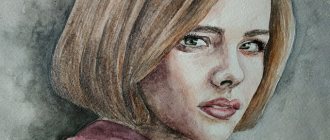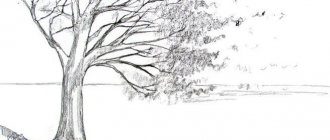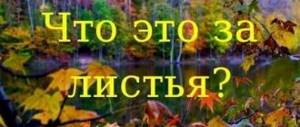Golden autumn drawing, step by step with photo
An example of a golden autumn drawing made in an unconventional technique - sponge painting. Such work will evoke positive emotions in the child, and will also show how to use familiar objects in drawing.
Materials:
- album sheet;
- gouache paint in four shades: red, yellow, green, brown;
- brushes;
- two foam sponges;
- scissors;
- disposable plates.
The contours of trees are drawn on the dense side of the sponges. Then carefully cut out the excess parts with scissors.
Three colors are diluted in plates to the consistency of sour cream: yellow, red and green.
Using a sponge, paint a yellow base on the sheet. Then they dip one tree template in yellow paint and the other in red paint and make neat impressions on paper.
On the sides of the picture there are imprints of fir trees and with a long stroke - the remains of green grass.
Add a little red to yellow trees.
At the top, the sun is depicted with a brush and the tree trunks are drawn with a brown tint.
Finally, reddish strokes are made at the base of the trees.
Beautiful autumn drawings, photos
Children's drawings have a special spirit. There are no rules or canons in them, only inspiration and a child's spontaneous soul. The autumn design can be voluminous or supplemented with natural materials: leaves, seeds and small fruits.
Gloomy late autumn is best drawn with pencils.
Multi-colored shading is another technique when the colors of felt-tip pens, pencils and even gel pens are mixed during the work.
It is commendable when parents support children's creativity. It not only brings people together, but also expresses individuality and helps cope with emotions.
Autumn drawing, grade 2, 3 options with explanations
Autumn drawing with cotton swabs
Materials:
- watercolor paints;
- watercolor paper;
- artist's masking tape (optional);
- straws;
- cotton buds;
- wide brush;
- water.
The edges of the sheet are covered with masking tape so that at the end you have a clean frame to work with. To obtain a beautiful graduated base, the sheet is first moistened with plain water and then a little color is added. While the paper is wet, draw clouds, then let it dry.
On the lower half of the sheet yellow, green and red shades are applied for the horizon. Leave the work to dry again. Mix black paint with water until it reaches the consistency of ink. A little paint drips at the bottom of the work. Then they give the children a tube to “blow out” parts of the trunk and branches. Where necessary, add paint. Let the work dry.
Using cotton swabs, yellow and red “leaves” are applied to the tree and underneath it.
Leaf under foil
The work with a leaf placed under thin foil (the top should be shiny) looks original. Use your fingers to gently stroke the metal material to develop the design. Then the base is covered with a layer of black gouache or ink. Leave the work to dry and carefully go over it with a steel wool. The veins will become shiny, but the grooves will remain dark. The relief is then placed on cardboard.
Tree in autumn
The following work was done using regular salt. To begin with, the sheet itself is moistened with a sponge, paint is applied and the wet background is sprinkled with salt.
After 10 seconds, shake off the salt and dry the workpiece itself. Grass and tree outlines are drawn and then painted in mixed autumn tones.
Children's drawings autumn
Children's drawings can convey a feeling of melancholy from rainy weather.
Autumn is the time for mushrooms, so it’s impossible to ignore the beauty of the delicious representatives of late autumn.
Many children associate the arrival of autumn with the Day of Knowledge.
Autumn pencil drawing, step by step master class
Step 1 Drawing begins by drawing a large "V" shape onto the paper using long, curved lines. Notice that the sides of the "V" are not straight, but wavy. One of the lines at the top has a small branch.
Step 2 Add a couple of long, curved lines to the drawing that go down from the "V" shape. This is a tree trunk that thickens slightly near the ground. Step 3 From the upper branches draw curved lines of different lengths on both sides.
Step 4 The two lines form another wide branch extending from the tree trunk. Then additional small branches are made.
Step 5 The tree trunk is covered with leaves.
Step 6 Add thick, irregularly shaped foliage with jagged ends. Step 7 Fallen drop-shaped leaves are depicted under the tree.
Step 8 Fill all the bald spots with additional branches, twigs and leaves. The trunk is detailed using curved lines of varying lengths. Step 9 Draw a second horizon line, rising above the first. Add unevenness on the ground and a few fallen leaves on it.
Step 10 A palette of colors is applied to the drawing: from golden yellow or copper to red-orange or brown. In the distance, following the principle of the given tree, you can add a whole forest.
Drawing autumn in kindergarten with paints:
Any children's autumn drawing, drawn with paints or a pencil, is replete with bright colors. Some people associate their favorite season with bunches of rowan berries, some with dreary rain, and for others it’s mushroom season. Kindergarten children are just beginning to master the technique of painting with paints, so simpler work is chosen for them and ready-made templates are often used.
junior group, step by step
Personal autumn drawing
The child traces his palm on a brown sheet of paper. Then it is cut out and glued to a white background - this will be the base of the tree.
Using a wine cork, multi-colored circles are randomly applied around the crown.
Autumn tree
The technique of drawing such a tree is so simple that even a three-year-old child can master it. For work, print out a template of the barrel, prepare paint, a brush and a round brush. Paints of different tones are squeezed onto separate plates: yellow, orange, brown and red. The brush is dipped into one of the flowers and applied to the tree, depicting leaves. The tree trunk is then painted brown.
Finger painting
Children can convey their vision of the world using fingerprints. Drawings using this technique are inimitable and unique. Initially, objects are depicted with handprints, and then switch to finger painting. For work, special paints are selected that are safe for the baby. In the center of the leaf there is a brown tree trunk. Then, dipping their fingers in yellow and red tones, they leave prints of multi-colored “leaves” around it.
middle group, step by step
The educational program of the middle group necessarily includes an autumn theme. To work, they use a variety of techniques and an unconventional approach.
Drawing with a wax candle
To work you need:
- a sheet of office paper;
- candle;
- paints;
- autumn leaves of different shapes.
The sheet is placed under the paper and rubbed over the surface with a candle. The print is covered with paint. There will be gaps where the protrusions have formed. Repeat similar steps with other leaves.
Green leaves are used for drawing, because... dry ones crumble when pressed.
Technique for drawing with wax crayons
To depict sheets, you will need office paper and wax crayons.
The sheet is covered with paper and chalk is drawn over it until an imprint appears. For brightness, the white background is glued onto colored cardboard.
Autumn landscape
Materials:
- sketch of a tree on paper or cardboard;
- brown pencil or oil pastel;
- Finger paint;
The baby’s hands must be washed before changing colors.
To begin, draw the outline of a tree on paper or print out a ready-made template. The barrel is covered with brown pencil or oil pastel. Finger paints of brown, yellow, red and orange are prepared on the palette. Dip your finger into one of the colors and press it to the paper. You can use one or all fingers for painting. They make multi-colored prints until the tree is filled with autumn leaves. Yellow paint is applied at its base with one finger stroke. You can add fallen leaves to the landscape or paint on birds and clouds. At the end, the work must be dried.
senior group, master class with photos
The drawing technique in the older group becomes a little more complicated. If a tree is transferred to paper, then the peculiarity of the crown structure, thickened trunk and its own bark color are already visible. Children's drawings must maintain proportion, close-to-far composition, and color possibilities.
"Wet" autumn landscape
Materials and tools:
- watercolor paper;
- soft brushes with a pointed tip;
- Toothbrush;
- a set of watercolor paints and a palette;
- a glass for wetting and washing brushes.
The brush is dipped in water and wetted well. The tree will be made in the form of a random cluster of clouds, so there is no need to be afraid that the child will ruin the work.
Watercolor is placed on top of the previous wet layer of paint. This painting technique is called “wet on wet”. For foliage, a combination of yellow, orange and olive green is used.
Mix a little brown and black to get a gray-brown tint and use a brush to draw the shape of the trunk and several branches.
Then they begin the most fun and easy watercolor painting technique. Dip a damp toothbrush into yellow and, holding the bristles with your finger, begin to spray paint over the surface of the paper.
Similar work is repeated with orange and olive flowers. A toothbrush gives the thin foliage a misty effect.
Larger splashes are made using two crossed brushes.
It is better to start the work with lighter colors and have another wet brush without paint on hand.
It is used to soften transitions. Floral prints
Using fruits and vegetables you can create interesting prints on paper. Children will definitely love this technique. Materials:
- fruits (apples, pears, oranges, bananas, lemons);
- vegetables (broccoli, cauliflower, bell peppers, potatoes, carrots, corn, mushrooms, Chinese cabbage);
- knife;
- cutting board;
- white cardboard;
- paper sketch (optional).
At the stage of cutting vegetables and fruits, children need adult help. Before use, fruits and vegetables are washed and dried. Approximate cutting:
- apples and pears - cut in half lengthwise;
- bananas - halved;
- oranges and lemons - cut in half;
- corn - in half, insert a tube for the handle;
- pepper - cut in half, remove seeds;
- broccoli and cauliflower - divided into separate inflorescences;
- mushrooms – sliced or halved lengthwise;
- potatoes and carrots - into quarters or specific shapes, such as a flower or a star.
Place the paint in small containers. Make a sketch of the drawing on paper. The fruit or vegetable preparation is dipped into the paint, evenly distributing it over the surface. The template is pressed tightly onto the paper, making an imprint.
To create a pattern, other blanks are used alternately. Each one has a unique and interesting imprint.
Broccoli plant prints are perfect for the trees, and rolling corn is perfect for the grassy layer.
Drawing with cotton swabs
A relatively new technique for children's creativity - drawing a picture on paper with paints and sticks - is very popular with children. For such creativity you need paper, cotton swabs and gouache diluted with water. Dot patterns are applied to the sheet with a light touch.
See how you can play on one theme, with one material, in several ways. Autumn bush
Trees in autumn
Autumn tree with background
All work was done with cotton swabs.
Drawings autumn 1st grade, 3 options with explanations
Alternatively, a child's drawing can be drawn using a real leaf and paints. To do this, take several sheets of different shapes, apply them to paper and draw an outline with a pencil. The middle is painted over with paints using a sponge or brush. Another way of painting is to apply paint to the underside of a sheet and press it to the surface of the sheet. The drawing is obtained by imprinting sheets of different sizes and shapes.
Landscape “In the Garden”
At the bottom of the sheet draw the outline of a hill. Then a counter line is drawn on the right side.
In the middle of the connection of two hills, another smaller one is depicted and two arched ones on the sides.
Drawing a tree starts from the base of the trunk.
Curved lines represent the main branches that are located inside the trunk. On both sides of the main branches, small branches with curved ends are drawn.
Leaves and fruits are added to the branches of the tree; several of them have already fallen to the ground.
To decorate the picture, choose autumn colors: yellow, brown, red and orange.
Collage of leaves
For work, leaves of various shapes and sizes are collected. Place one of them on a flat surface and cover with paper. Gently stroke the paper surface with crayons or oil pastels to create a stencil shape. Then the sheet is removed from under the paper and the next one is placed. It can be painted in a different color.







